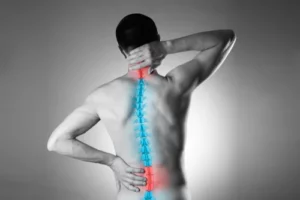In the quiet corners of our routine life, amidst the hustle and bustle, you might have noticed an unsettling duo of sensations – a nagging neck pain, seemingly resonating with irregular patterns of breathlessness. It feels like an unsung narrative, where the agony in your neck is conducting a silent dialogue with the heaviness of your breath. You pause, ponder, and find yourself wading through a sea of questions. “Is there a deeper connection? Are these signs interlinked in ways more intricate than they appear?“So, let’s join hands as we venture into this uncharted territory, piecing together the puzzle that binds neck pain and shortness of breath in a symphony that beckons understanding and empathy.
Contents
Understanding the Anatomy of the Neck and Respiratory System
In the marvelous architecture of the human body, two seemingly disparate regions – the neck and the respiratory system – engage in a subtle dance of interconnected functions. It’s an intricate interplay, one that warrants a deeper exploration to unveil the ways in which ailments in one can cascade disturbances in the other. In this enlightening segment, we will navigate the complex pathways that bind the neck region to the respiratory system, a voyage that promises to unravel the scientific bases of their relationship.
From stabilizing the head to housing the pharynx and larynx – vital components of the respiratory tract – the neck plays a pivotal role in ensuring seamless breathing processes. It is here that we begin to see the glimpses of a connection, a gentle nudge towards understanding that issues affecting the neck can reverberate, influencing our respiratory rhythms.
So, as we delve deeper, it becomes apparent that the mechanics of breathing are indeed influenced by the condition of the neck. Muscles in the neck assist in the primary function of respiration – the act of inhaling and exhaling. Disorders affecting these muscles can potentially alter the harmony, leading to disturbances in breathing patterns, manifesting as shortness of breath.
Common Symptoms: Neck Pain and Shortness of Breath

Navigating through the maze of symptoms that come with neck pain and breathlessness can sometimes be akin to deciphering a complex language. Let us help you decode this language by delineating the common symptoms associated with neck pain and breathlessness, and how to distinguish them from other health concerns.
Neck pain, often a repercussion of strain or injury, manifests in various forms. From a dull, lingering ache to an intense, stabbing pain, the experiences can be vast and varied. Accompanying this primary discomfort, individuals might notice additional symptoms such as:
- Stiffness limiting the range of motion
- Sharp pain localized in one spot
- Radiating pain extending to shoulders and arms
- A tingling or numbness sensation, sometimes hinting at nerve involvement
- Headaches, often originating from the neck
Shortness of breath or breathlessness, on the other hand, often comes with its own set of narratives. Common manifestations might include:
- Difficulty in drawing a deep breath
- A feeling of tightness or constriction in the chest
- Increased respiratory rate, seemingly without exertion
- Gasping for breath during regular activities
- The onset of anxiety due to breathlessness
Identifying overlapping symptoms, such as heightened anxiety accompanying both neck pain and breathlessness, can be a gateway to unveiling a deeper connection.
Possible Causes Behind the Connection
As we further unravel the intertwined phenomena of neck pain and shortness of breath, it is imperative to cast a discerning eye on the potential causes that bridge these two conditions. So, let’s venture into the diverse landscapes of possible causes, drawing connections and fostering an understanding that might be your key to relief.
Medical Conditions at a Glance
 The medical realm holds a plethora of conditions that can potentially ignite the twin flames of neck pain and breathlessness. Some of the medical conditions that can potentially link these symptoms include:
The medical realm holds a plethora of conditions that can potentially ignite the twin flames of neck pain and breathlessness. Some of the medical conditions that can potentially link these symptoms include:
- Cervical Spondylosis: A degenerative condition affecting the cervical spine, possibly influencing the nerves and muscles involved in respiration.
- Thoracic Outlet Syndrome: A group of disorders occurring when the blood vessels or nerves in the space between the collarbone and first rib (thoracic outlet) are compressed, affecting both neck mobility and respiratory function.
- Anxiety Disorders: Heightened anxiety can sometimes manifest as both neck stiffness and shortness of breath, creating a cyclical pattern of discomfort.
- Cardiovascular Issues: Certain heart conditions might present with both neck pain and breathlessness, signaling a need for immediate medical attention.
Habits and Lifestyle Influences
 Lifestyle choices and habits can sometimes be silent instigators, gradually weaving a web of issues that encompass both the neck and respiratory regions. These might include:
Lifestyle choices and habits can sometimes be silent instigators, gradually weaving a web of issues that encompass both the neck and respiratory regions. These might include:
- Poor Posture: Habitual slouching or hunching can put undue stress on the neck muscles, potentially affecting breathing patterns.
- Sedentary Lifestyle: A lack of physical activity can lead to weakened neck and chest muscles, thereby affecting respiratory efficiency.
- Smoking: A well-known irritant to the respiratory system, smoking can also exacerbate neck pain due to the inflammation it causes.
Injuries that Forge the Link
Injuries, be it accidental or through wear and tear, can sometimes be the connecting bridge between neck pain and shortness of breath. However, instances where this might occur include:
- Whiplash: A sudden jolt or impact can cause whiplash, affecting the neck muscles and potentially leading to breathing difficulties.
- Sports Injuries: Certain sports injuries might encompass both the neck and chest region, bringing about a simultaneous onset of neck pain and breathlessness.
As we navigate the labyrinth of potential causes, it becomes vital to adopt a holistic approach, weaving together insights from various medical disciplines to paint a complete picture. This not only aids in pinpointing the exact cause but also paves the way for targeted and effective interventions.
Management Strategies: Alleviating Neck Pain and Breathlessness
In a world where the duo of neck pain and shortness of breath seems to intertwine more often than we’d like, finding solace through effective management strategies becomes not just a relief, but a necessity. So, let’s walk through these avenues of relief together.
Embracing Therapies
 Therapies often serve as a gentle yet potent means to address both neck pain and breathlessness. A few therapies that have shown promise are:
Therapies often serve as a gentle yet potent means to address both neck pain and breathlessness. A few therapies that have shown promise are:
- Physical Therapy: Engaging with a skilled physical therapist can help devise a customized plan to strengthen neck and respiratory muscles, potentially reducing the incidence of these symptoms.
- Chiropractic Care: Regular sessions with a chiropractor can help in realigning the spine and relieving neck pain, which in turn might ease breathlessness.
- Breathing Techniques: Learning specific breathing techniques can assist in managing episodes of shortness of breath effectively.
- Massage Therapy: Gentle massage can relieve muscle tension in the neck, potentially improving respiratory function.
Lifestyle Changes: A Path to Wellness
Sometimes, the key to alleviation lies in adapting to beneficial lifestyle changes. These might include:
- Ergonomic Adjustments: Ensuring a workspace that promotes good posture can prevent neck strain and foster better breathing.
- Nutrition and Hydration: Maintaining a balanced diet and staying hydrated can support overall health, including the neck and respiratory system.
- Stress Management: Implementing strategies to manage stress can potentially reduce the occurrence of both neck pain and breathlessness.
Exercises to Foster Relief
 Embarking on a journey of exercises can be a proactive step towards mitigating the symptoms. Therefore, here are a few exercises that might be beneficial:
Embarking on a journey of exercises can be a proactive step towards mitigating the symptoms. Therefore, here are a few exercises that might be beneficial:
- Neck Stretches and Tilts: Regular neck exercises can enhance flexibility and reduce stiffness.
- Pranayama: This ancient practice focuses on controlled breathing, which can potentially improve lung function and reduce neck tension.
- Aerobic Exercises: Engaging in regular aerobic exercises can improve overall respiratory function and possibly reduce neck pain.
Consulting a Professional: When to Seek Help
Navigating the stormy seas of neck pain and breathlessness can sometimes be a solitary journey, one filled with uncertainty and apprehension. However, there comes a pivotal moment when reaching out for a guiding hand becomes not just an option, but a necessity. So, let’s delve into the signals that beckon the intervention of a seasoned professional.
Recognizing the Warning Signs
The first step in seeking help is to recognize the signs that indicate that a professional intervention might be required. These signs can include:
- Persistent Symptoms: If neck pain and breathlessness persist over an extended period, defying home remedies and rest.
- Intensifying Discomfort: When the level of discomfort escalates, hindering daily activities and diminishing quality of life.
- Sudden Onset: If the symptoms appear suddenly, without any apparent cause, signaling a potential underlying issue.
- Accompanying Symptoms: The presence of other symptoms such as chest pain, dizziness, or numbness in limbs, which might indicate a more serious condition.
Approaching a Healthcare Provider
Once you have identified the critical signs, the next step is to approach a healthcare provider adept at handling such cases. So, here is how you can go about it:
- Primary Care Physician: Start with consulting your primary care physician who can assess your condition and guide you to the appropriate specialist if needed.
- Specialist Consultation: Depending upon the initial assessment, you might be referred to specialists like orthopedic doctors or pulmonologists for a more detailed evaluation.
- Emergency Services: In cases where the symptoms are severe or accompanied by signs of a potential emergency, do not hesitate to seek immediate medical attention through emergency services.
Collaborative Healthcare Journey
Embarking on a healthcare journey with a professional means stepping into a collaborative experience where your inputs matter. Be prepared to:
- Share Detailed History: Providing a detailed history of your symptoms, including their duration and any triggering factors.
- Follow Up Regularly: Adhering to regular follow-ups to monitor the progress and adjust the treatment plan as necessary.
- Active Participation: Being an active participant in your healthcare journey, keeping an open line of communication with your healthcare provider.
Conclusion
In our journey through the labyrinthine connections between neck pain and shortness of breath, we have unearthed the intricacies of symptoms, delved deep into potential causes, and navigated through avenues of management strategies. However, one cannot underscore enough the significance of professional intervention in this journey. As we stand at the crossroads of discernment and action, it becomes imperative to choose a path that leads to lasting relief and a richer quality of life.
At this juncture, we would like to extend a helping hand to guide you further along this path of recovery. If you find yourself grappling with persistent neck pain, physical therapy for neck pain at PhysioMantra can help: Book an online physical therapy session.



